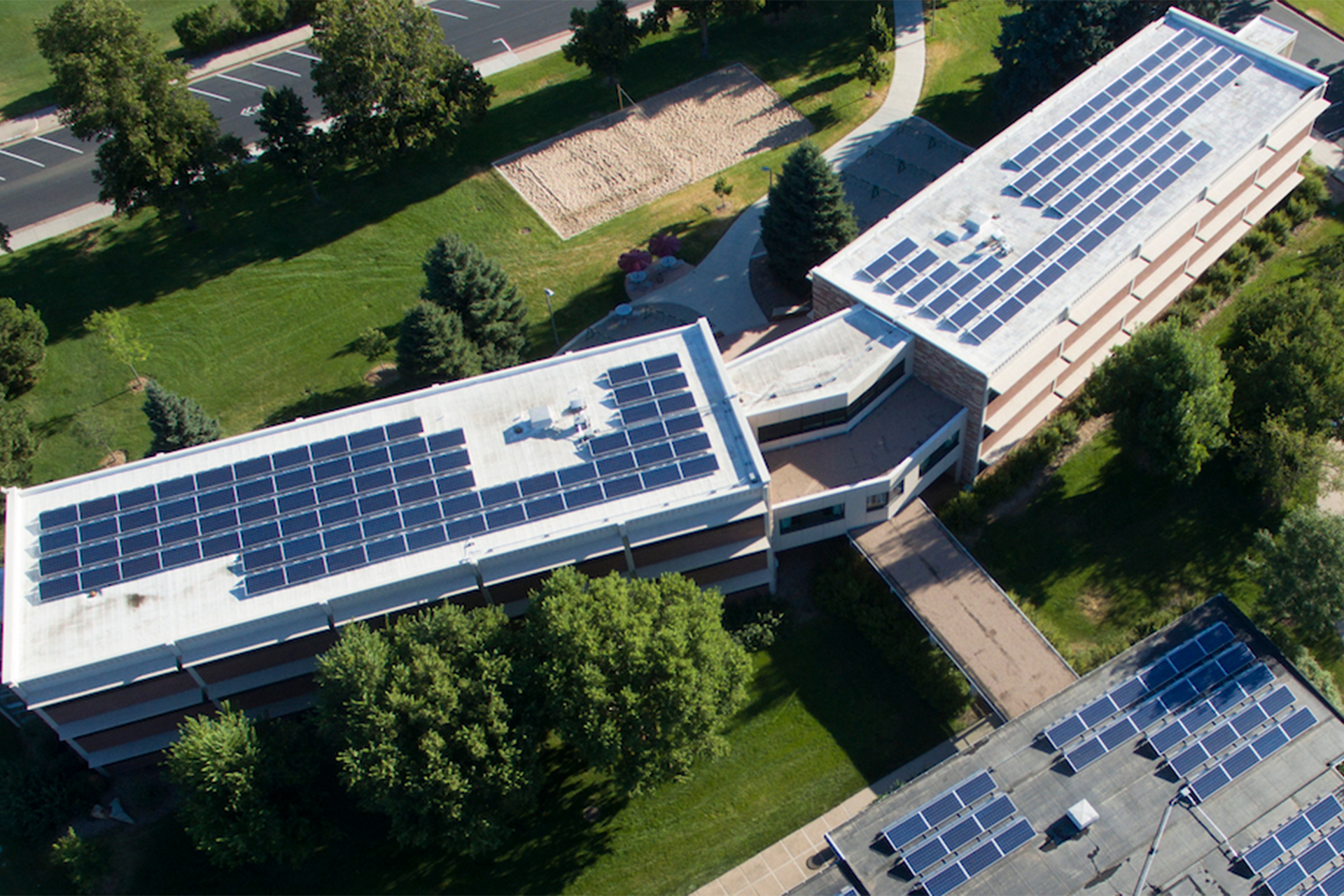
Solar panels on top of Edwards Hall.
Carol Dollard gets really excited talking about renewable energy certificates. Her hands gesticulate, and it’s difficult not to buy into her enthusiasm … even if you have no idea what she’s talking about.
Dollard, co-chair of the Colorado State University President’s Sustainability Commission and an energy engineer for Facilities Management, is a devoted advocate of all things sustainability. And she understands that the concept of RECs can be challenging to wrap your head around.
“It’s hard for a lot of people to understand, but RECs are important to CSU and demonstrates our commitment to a 2030 goal of 100% renewable electricity,” she said. “Plus, it’s just the right thing to do for our environment.”
Simply stated, RECs represent the environmental aspect of the energy generated by renewable energy sources; think wind or solar power. Although purchasing RECs is not the same as directly buying the electricity, RECs represent the clean energy attributes of renewable electricity. A REC that has been sold once cannot be purchased again. All RECs are uniquely numbered and generally include information such as where they were generated, the type of renewable resource they came from, and a date stamp of generation. The exchange of RECs is tracked and recorded by third party verifying organizations.
CSU recently purchased enough RECs to offset 25% of the total electricity use for the university and Housing and Dining Services (HDS) bought enough to offset 100% of the electricity use in their buildings, including residence halls and dining areas, for the 2019 fiscal year.
These REC purchases — totaling about $40,000 — help CSU reduce its greenhouse gas footprint by funding carbon reduction projects in other locations. HDS first purchased RECs for its common spaces in 2004, the same year students were allowed to purchased RECs to offset electricity use in their rooms. The first LEED project at CSU to purchase RECs was during the 2005 Guggenheim Hall renovation project. Although CSU has been buying RECs for nearly 15 years, the recent purchase is the largest to date.
The mountain lake
Dollard has explained the concept of RECs so many times she has created an analogy:
Picture a mountain lake with streams feeding into the lake and other streams taking flowing water out. The electric grid is the lake and the streams flowing into the lake represent energy generated – coal powered, hydro, solar, wind – and the streams exiting provide energy for anyone on the grid. All of the water mixes together in the lake, regardless of how it was originally generated.
“Through the purchase of RECs, we’re making that lake cleaner,” she said. “We’re providing funding for someone to produce cleaner electricity to helps feed the lake with clean energy generated by solar, wind or hydro. We’re making the grid cleaner overall.”
Stacey Baumgarn, CSU’s campus energy coordinator, said 50% of the University’s greenhouse gas emissions comes from electricity. Purchasing RECs, whether large or small, help move the marketplace and ensure that additional clean electricity projects can be created locally and nationally.
CSU has several renewable electricity projects, including 18 solar arrays like the one on the Behavior Sciences building that in total produce more than 10,000 megawatt hours of solar production, but he believes RECs are also an important tool to help green the grid.
“We are doing tangible things, but the RECs move the market to make the university and Fort Collins goal of 100% renewable electricity by 2030 achievable. Everybody in our community will benefit from a cleaner grid.”
— Stacey Baumgarn, CSU’s campus energy coordinator
“We are doing tangible things, but the RECs move the market to make the university and Fort Collins goal of 100% renewable electricity by 2030 achievable,” he said. “Everybody in our community will benefit from a cleaner grid.”
CSU students on board
Mary Liang, assistant director of sustainability for HDS, said CSU students have played a significant role in sustainability efforts on campus. She cited ASCSU’s approval to use $100,000 in student fees for additional solar panels on the Lory Student Center and annual Earth month events.
Additionally, HDS’s student-run Eco Leader Program sponsors an annual Green Warrior Challenge to engage students in sustainability in everyday life, which resulted in more than 3,000 trees planted last year. “The students are dedicated,” Liang said. “They want action right now and they will continue to ask for these projects across our campuses. They definitely have a sense of urgency.”
CSU sophomore Delaney McLelland feels that urgency. “With a lot of big companies polluting the earth in various ways, it’s great to see CSU doing its part for the environment,” she said. “Knowing that I go to a school that cares about sustainability makes me proud to be a Ram.”
To learn more about sustainability efforts at CSU visit the CSU Sustainability Initiatives Overview page and the HDS annual Sustainability Report. To view physical sustainability efforts on campus, visit the interactive campus map.